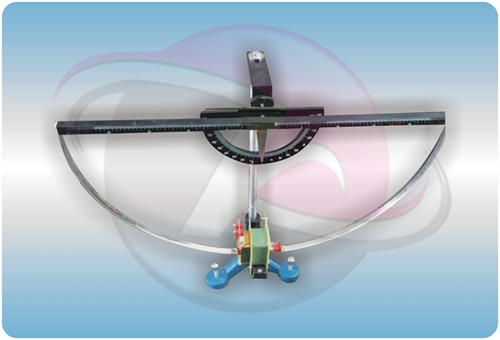E.M.F induced as a function of the velocity of the magnet
(Electromagnetic induction)

E.M.F induced as a function of the velocity of the magnet
(Electromagnetic induction)
A magnet mounted at the centre of the semi-circular frame of aluminium with a circular scale graduated in degree carrier by it near the shape edged fulcrum. A coil of large no of turns of thick insulated copper wire wound over a wooden frame. Base board carrying a resistance diode, condenser and a galvanometer or micro meter with zero at the centre of scale and a high resistance voltmeter with a tapping key connected in parallel with condenser, connecting leads etc
Faraday's law of electromagnetic induction tells us that a change in magnetic flux gives rise to an induced emf " given by.
It consists of a permanent magnet mounted on an arc of a circle of radius 50cm. The arc is part of a rigid frame of aluminiumand is suspended at the centre of the arc so that the whole framecan oscillate freely in its plane. Weights have beenprovided, whose positions can be altered so that the time periodof oscillation can be varied from about 1.5 to 3 sec. Two coilsof about 10,000 turns of copper wire loop the arc so that themagnet can pass freely through the coil. The two coils are independent and can be connected either inseries or in parallel. The amplitude of the swing can be read fromthe graduations on the arc. When the magnet moves throughand out of the coil, the flux of the magnetic field through thecoil changes, inducing the emf.
Scope of Learning
1. To study the flux and emf in the coil as a function of time.
2. To study the maximum emf and total flux as a function of the velocity of the magnet.
3. To demonstrate damping due to induced current.
